The Neck Cloth Timeline
1700-1730
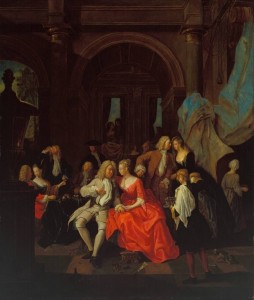
Angellis – Conversation Piece – c.1725
For the first 3 decades the fashion seemed to be to not to wear a Neck cloth. A strange way to start a page on neck cloths we know, but you can’t alter history.
Instead the paintings are full of ladies with wide, sweeping necklines with only the ruffles from their shift or their Tucker being seen. Peter Ange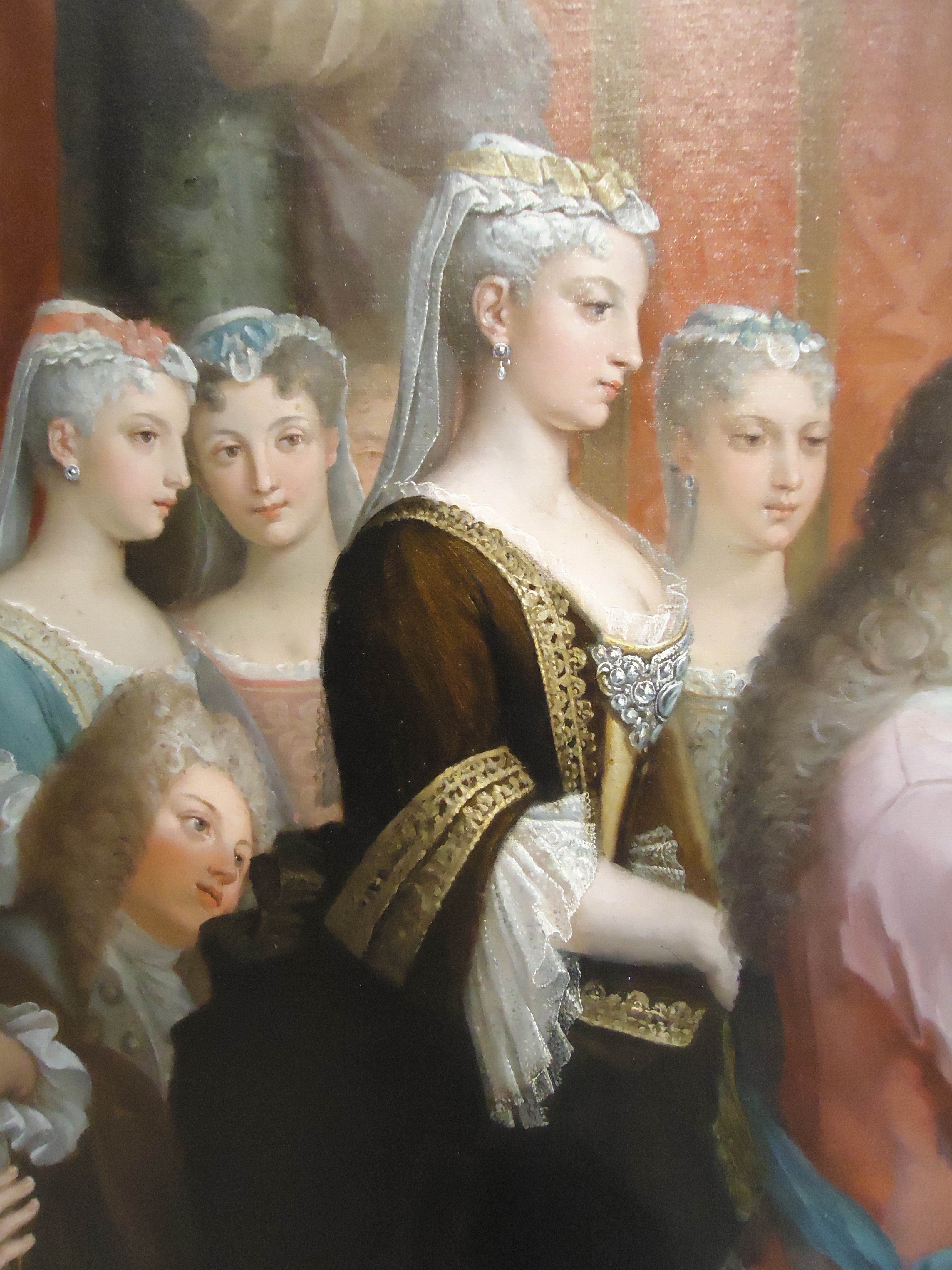 llis’ ‘Conversation Piece’ in the Tate is a clear example of this (see above). Dated 1715-20, none of the 3 main ladies being fashionably displayed here have any form of neck attire – just a light, sprightly ruffle edging their gown. It’s a funny look because the men are neck-clothed up to the eyeballs in this painting and stand as a complete contrast to the women. Another Painting that sits in perfectly with this understanding of early 18th C. fashion (and running right alongside the ‘Caps worn in Court’ sketches for the year 1725 by Bernard Lens) is the large and wonderful painting of ‘The Baptism of Prince Charles Stuart’ painted in the Scottish Court by Antonio David, 1725. We’ve included a detail of this painting here (2nd Image – Upper left) as it really builds on this look that fills the early 18th C. portraiture and vastly includes no neck cloths! Let us make it clear that these images supply us with the FASHION for this period, no doubt working women were still going about, swathed in their neck cloths and in the images below we get to see as the 20’s progress; neck cloths and in particular the ‘Through the Lacing’ Method begin to be displayed in the homes of the Landed Gentry.
llis’ ‘Conversation Piece’ in the Tate is a clear example of this (see above). Dated 1715-20, none of the 3 main ladies being fashionably displayed here have any form of neck attire – just a light, sprightly ruffle edging their gown. It’s a funny look because the men are neck-clothed up to the eyeballs in this painting and stand as a complete contrast to the women. Another Painting that sits in perfectly with this understanding of early 18th C. fashion (and running right alongside the ‘Caps worn in Court’ sketches for the year 1725 by Bernard Lens) is the large and wonderful painting of ‘The Baptism of Prince Charles Stuart’ painted in the Scottish Court by Antonio David, 1725. We’ve included a detail of this painting here (2nd Image – Upper left) as it really builds on this look that fills the early 18th C. portraiture and vastly includes no neck cloths! Let us make it clear that these images supply us with the FASHION for this period, no doubt working women were still going about, swathed in their neck cloths and in the images below we get to see as the 20’s progress; neck cloths and in particular the ‘Through the Lacing’ Method begin to be displayed in the homes of the Landed Gentry.
As we enter the twenties – the neck cloth finally decides to show it’s face. Our first entry of a cloth being worn is in the painting by Marcellus Laroon and dated c.1720. It’s called ‘A Musical Assembly’ and is a dark image so bear with us if you struggle to see the cloth – it’s the upright lady taking centre stage in the painting and she wears a blue cloth looped in a ‘Tied Method‘. This is a vague beginning for the neck cloth- there are not many coloured cloths in the nobility fashions – generally white for most of the century with a vogue for sheer black cloths in the 60s and 70s but we’re sticking to our guns and sounding this as the first recording.
For the next 10 years though, it’s still a real battle between Cloth vs Ruf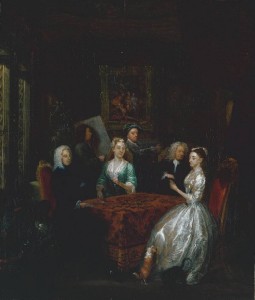 fle. It does appear that the younger ladies and those wearing a higher ‘Dress’ fashion tend to not wear a cloth – ruffles being preferred and they can be seen quite deep for this period. So, our next entry of a cloth being worn is in a painting entitled ‘Elegant Company Playing Cards’ and dated c.1725, attributed to Gawen Hamilton (please see to the left). Though it is not definite which technique they are using, they are certainly wearing neck
fle. It does appear that the younger ladies and those wearing a higher ‘Dress’ fashion tend to not wear a cloth – ruffles being preferred and they can be seen quite deep for this period. So, our next entry of a cloth being worn is in a painting entitled ‘Elegant Company Playing Cards’ and dated c.1725, attributed to Gawen Hamilton (please see to the left). Though it is not definite which technique they are using, they are certainly wearing neck 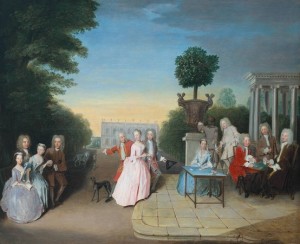 cloths and it does have a ‘Through the Lacing’ look to it. We’re also going to use the painting of The Schutz Family by Philip Mercier and also dated 1725. It’s indicative that only one lady is wearing a neck cloth in this painting – please see the lady in blue at the table. We believe that it’s this point in history where the neck cloth becomes to creep back into ‘fashionable’ fashion.
cloths and it does have a ‘Through the Lacing’ look to it. We’re also going to use the painting of The Schutz Family by Philip Mercier and also dated 1725. It’s indicative that only one lady is wearing a neck cloth in this painting – please see the lady in blue at the table. We believe that it’s this point in history where the neck cloth becomes to creep back into ‘fashionable’ fashion.
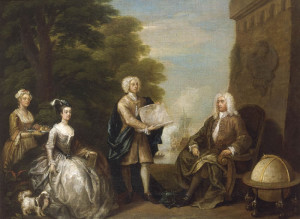 There are 4 Methods we’ve spotted in this period. Undoubtedly the ‘Through the Lacing‘ Method is the most popular – especially among the Fashionable, but a servant in Hogarth’s painting of ‘Captain Woodes Rogers and Family’ – 1729, (see above and left) shows the fashionable lady bare necked but her maid carrying the tray behind her wearing a ‘Tucked in’ Method – please welcome this to the stage! And A lady in Watteau’s L’enseigne de garsaint is wearing the ‘Twist‘ Method (again please welcome graciously and look below). Although, we have to add at this point that this ‘Twist’ Method used here is French – we’ve yet to see this method used on an ordinary neck cloth in Britain. Ther
There are 4 Methods we’ve spotted in this period. Undoubtedly the ‘Through the Lacing‘ Method is the most popular – especially among the Fashionable, but a servant in Hogarth’s painting of ‘Captain Woodes Rogers and Family’ – 1729, (see above and left) shows the fashionable lady bare necked but her maid carrying the tray behind her wearing a ‘Tucked in’ Method – please welcome this to the stage! And A lady in Watteau’s L’enseigne de garsaint is wearing the ‘Twist‘ Method (again please welcome graciously and look below). Although, we have to add at this point that this ‘Twist’ Method used here is French – we’ve yet to see this method used on an ordinary neck cloth in Britain. Ther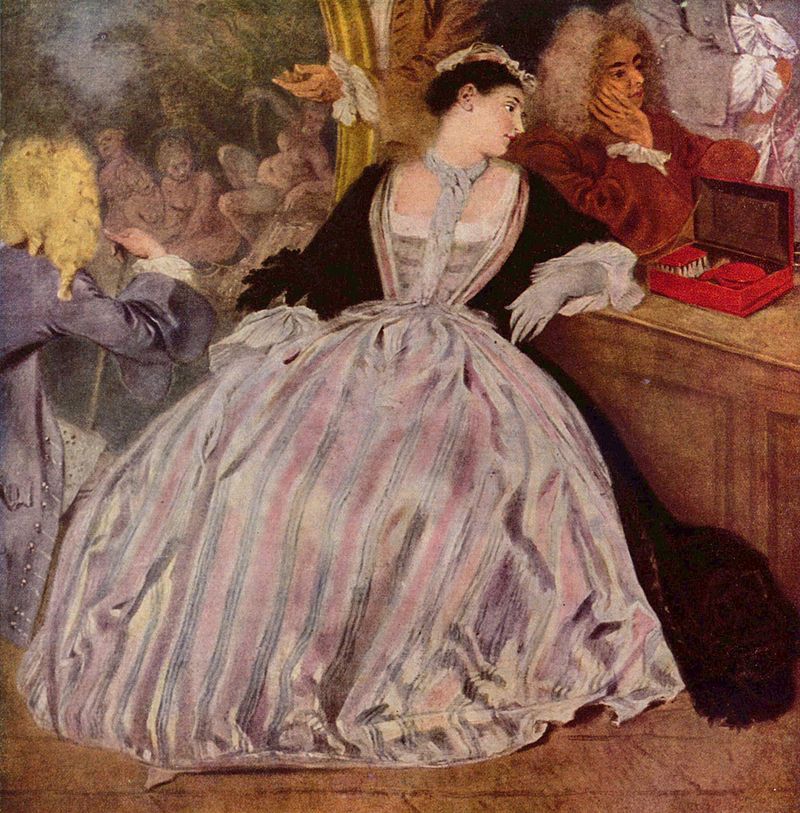 e are certainly examples of lace, chenille and furbelows being twisted round the neck but not with a simple neck cloth. Watteau, who is famous for this period, only has two ladies in the entire collection that we have of his paintings that wear some kind of neck cloth. One wears a twist of what is likely to be lace and the other is the serving girl across the counter from her and wearing what is possibly a cheaper version. It is the painting that we’ve used that these ladies appear and is dated 1720. Ple
e are certainly examples of lace, chenille and furbelows being twisted round the neck but not with a simple neck cloth. Watteau, who is famous for this period, only has two ladies in the entire collection that we have of his paintings that wear some kind of neck cloth. One wears a twist of what is likely to be lace and the other is the serving girl across the counter from her and wearing what is possibly a cheaper version. It is the painting that we’ve used that these ladies appear and is dated 1720. Ple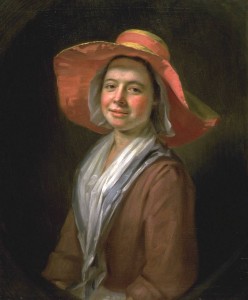 ase click on the link here for more info on this painting: ‘L’enseigne de garsaint’
ase click on the link here for more info on this painting: ‘L’enseigne de garsaint’
Plummeting from the dizzy heights of the Fashionable and the Genteel Society, we’re going to drop into the more Working Class side of fashion and use an image by Balthezar Denner, entitled ‘Girl in Straw Hat’ and dated 1723. We’re classing the way she wears her neck cloth as ‘Loose‘ Method (a respectful round of applause please and look right!). One last working class image for this early period is another example of the ‘Tied’ Method. It’s a painting by Peter Angellis again and is of Covent Garden Market, dated 1726 ( see below). There are 2 wea lthier looking ladies without cloths but our little gem is seated to the left and wears a clean, white full neck cloth about her neck with a loose tie. Also, just out of interest there is a lady with her Apron pinned back – it’s another ongoing research topics of ours.
lthier looking ladies without cloths but our little gem is seated to the left and wears a clean, white full neck cloth about her neck with a loose tie. Also, just out of interest there is a lady with her Apron pinned back – it’s another ongoing research topics of ours.
As the years move on and the twenties becomes the thirties, there is still this persistence with the Cloth vs Ruffle in the Genteel society but there is also a growing favour of the Neck Cloth. In our next im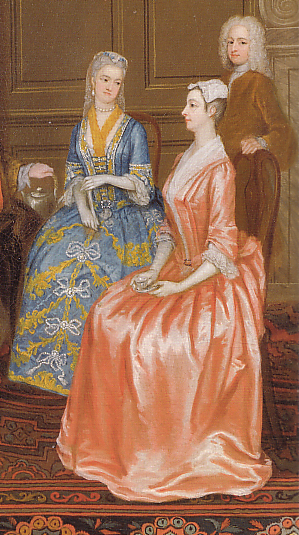 age, dated c.1730s we see two ladies at a Social Function and who are both wearing cloths – though one is very different. It is entitled ‘Tea Party at Lord Harringtons’ by C.Philip (please look left). The Lady in Blue wears a twist of Chenille which is an example of what we were talking about above with the Twist method being mostly worn with something other than a cloth here in the UK. The lady in salmon pink though, has a cloth worn under the Robings and over her stomacher but interestingly no real evidence of it being tucked under anything connecting the Robings – she does however appear to have a small buckle at her waist which could be holding the tail ends – we’ve classed this a s ‘Through the lacing’ method as although it’s not gone ‘through’ any ‘lacing’ it’s also not just tucked in at her neckline but has been pulled flat over her stomacher and under the robings which has the same effect and look as a ‘Through the Lacing’ technique.
age, dated c.1730s we see two ladies at a Social Function and who are both wearing cloths – though one is very different. It is entitled ‘Tea Party at Lord Harringtons’ by C.Philip (please look left). The Lady in Blue wears a twist of Chenille which is an example of what we were talking about above with the Twist method being mostly worn with something other than a cloth here in the UK. The lady in salmon pink though, has a cloth worn under the Robings and over her stomacher but interestingly no real evidence of it being tucked under anything connecting the Robings – she does however appear to have a small buckle at her waist which could be holding the tail ends – we’ve classed this a s ‘Through the lacing’ method as although it’s not gone ‘through’ any ‘lacing’ it’s also not just tucked in at her neckline but has been pulled flat over her stomacher and under the robings which has the same effect and look as a ‘Through the Lacing’ technique.
Next we have 2 of Charles Philips Family Group paintings. Although there is still a lot of un-clothed necks in our images of the 30’s, most of the ladies in these following paintings have cloths – which is nice. We can’t shrink the image too much or you won’t be able to see anything.
In a painting by Lancret and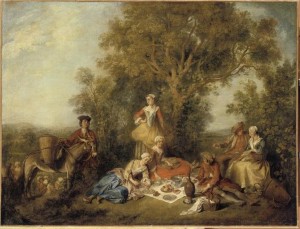 dated 1738 and entitled ‘Autumn’ (see left) all 4 of the ladies are wearing cloths. 2 of them seem to be clearly using the ‘Crossed Over’ method whilst possibly the one in the blue skirt is using a ‘Tucked in’ method and the other is indescript. This is the first time (based on our collection of images only!) that the ‘Crossed Over Method’ has been seen. Until the 80’s, this matches our understanding that the ‘Crossed Over’ method was more of a working class or lower class method of wearing a Neck Cloth.
dated 1738 and entitled ‘Autumn’ (see left) all 4 of the ladies are wearing cloths. 2 of them seem to be clearly using the ‘Crossed Over’ method whilst possibly the one in the blue skirt is using a ‘Tucked in’ method and the other is indescript. This is the first time (based on our collection of images only!) that the ‘Crossed Over Method’ has been seen. Until the 80’s, this matches our understanding that the ‘Crossed Over’ method was more of a working class or lower class method of wearing a Neck Cloth.
Next is the fabulous E. Hemyng portrait (great name!…and please look right) painted by Devis with his usual clear cut realism but less of his sparse coldness in this particular portrait. The date for this painting has been estimated to be between 1738-40 and you can see quite clearly her neck cloth tucked between her robings and under her central Breast Knot (see glossary for more info) using the ‘Through The Lacing Method’. She is a brilliant 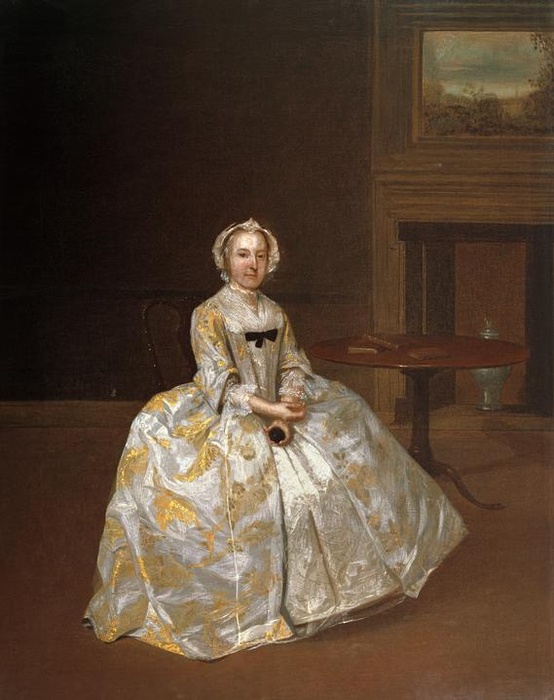 example also of the ideal image and silhouette that the mid 18th c fashion eye was going for – this rigid, almost bigger than life, forced cone like shape, which held the body in that smooth cylindrical position and then had the dress pulled tight over it so that the smooth, cone shape of the stays beneath sung out. Everything else exploded from this central controlled area – the skirts, the sleeves, the neck cloth, the apron. It was a silhouette that predominates most of the 18th c, though with slight nuances as the century progresses. You can also see in this image the impossibly fine apron which could be the beginning of the fineness on cloths that we being to see later on in the next decade (bear with us – that’s later on in the 50s). Her ruffles are fine also and her sleeves and their cuffs hold the bagginess that they will begin to lose also over the next decade or so. To be honest we wouldn’t be surprised if someone discovered that this image was in fact, smack bang from the middle of 1750s.
example also of the ideal image and silhouette that the mid 18th c fashion eye was going for – this rigid, almost bigger than life, forced cone like shape, which held the body in that smooth cylindrical position and then had the dress pulled tight over it so that the smooth, cone shape of the stays beneath sung out. Everything else exploded from this central controlled area – the skirts, the sleeves, the neck cloth, the apron. It was a silhouette that predominates most of the 18th c, though with slight nuances as the century progresses. You can also see in this image the impossibly fine apron which could be the beginning of the fineness on cloths that we being to see later on in the next decade (bear with us – that’s later on in the 50s). Her ruffles are fine also and her sleeves and their cuffs hold the bagginess that they will begin to lose also over the next decade or so. To be honest we wouldn’t be surprised if someone discovered that this image was in fact, smack bang from the middle of 1750s.
Between our jam-packed images, can we just break in for a moment and give a quote from Iris Brooke on the subject of Neck Cloths and using a quote from the 1730s? (Just perhaps a little relevant) It come from her book ‘Dress and Undress’and she states on p.81, that in 1734 the French fashions were beginning to wear their stays incredibly low – the English ‘counteracted this difficulty by wearing a kerchief or scarf pinned to the bodice with buckles and a strap or ribbon between.’ (This description counts as the ‘Through the Lacing’ Method but we’d not ever noticed the ‘pinning’ bit before. Interestingly it could also describe the Salmon Lady in C.Philips painting above). She goes onto quote that in 1736, the Gentleman’s Magazine said “…though she conforms as near as she can to the fashion in stays, to correct the immodesty of the mode with a neck cloth or handkerchief and hide certain bewitching allurements from a curious eye…”. We are pleased as punch with this – for starters he uses the terms ‘Neck Cloth’ and 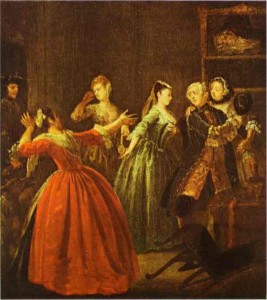 ‘Handkerchief’ and also these stays must’ve been being worn incredibly low as the necklines in the early 20’s painting as seen above aren’t exactly high necked!
‘Handkerchief’ and also these stays must’ve been being worn incredibly low as the necklines in the early 20’s painting as seen above aren’t exactly high necked!
For the 1730’s images of more working class women, or let’s say the Lower Middling Sort and Under, we have a couple of images. One is displaying the ‘Loose Method’ and is found in Hogarth’s ‘Theft of a Watch’. The lady with her back to us is the one with her neck cloth hanging free. You can also use the Lancret image above as it’s likely these ladies were of a lower status. There is also plenty of back scenes in the Covent Garden Painting.

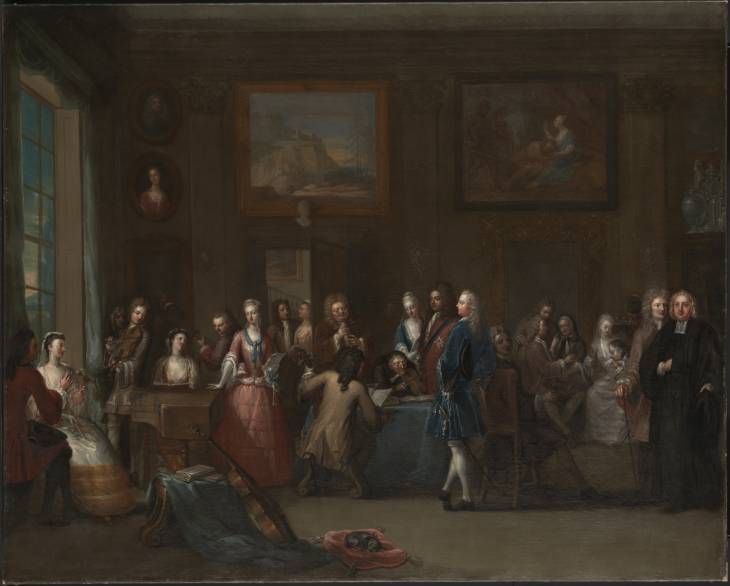
![The Watson-Wentworth and Finch Families *oil on canvas *100.3 x 124.5 cm *signed (l.l.): C Philip[?] Pinxit *ca. 1732](https://handboundcostumes.co.uk/wp-content/uploads/2015/07/C.Philips-wentworth-and-finch-family-1732.jpg)


